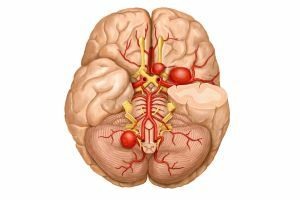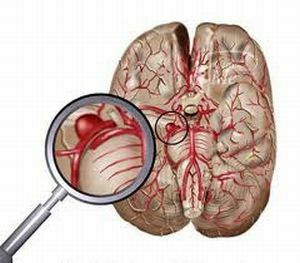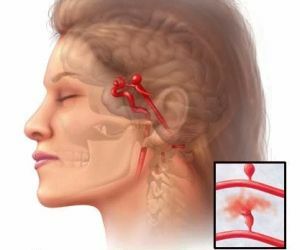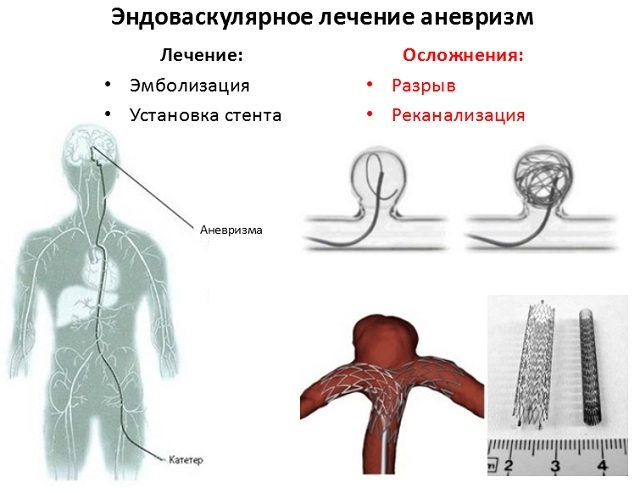 An aneurism of cerebral vessels is also known as cerebral, intracranial or intracranial. It is a bulge on the vessel.
An aneurism of cerebral vessels is also known as cerebral, intracranial or intracranial. It is a bulge on the vessel.
Sometimes it ruptures, causing a brain hemorrhage, in which blood splashes into the space around the brain. These areas are called subarachnoid and, consequently, this type of hemorrhage in the brain is called a subarachnoid hemorrhage.
It is one of the causes of stroke, can lead to serious brain damage and death.
Contents
- Statistical indices
- Reasons for the onset
- Clinical picture
- Diagnostic criteria and methods
- Objectives and methods of therapy
- What is the danger?
- Consequences of an aneurysm as such
- Complications and consequences associated with the diagnosis of
- Difficulties associated with the treatment of
- How to prevent the development of the disease?
Statistical indices of
Approximately, in 0.2-3.0% of cases there is an aneurysm rupture of the brain and bleeding. For example, 30,000 such patients are registered annually in the United States, of which 10-15% die before they enter the hospital, and more than 50% die despite treatment within the first 30 days.
Even from those who survived, more than half are subject to permanent neurological disability. Aneurysm of cerebral vessels can be affected at any age, but most often - at the age of 35-60 years( more often in women).

Causes of
 First of all, it is necessary to mention the genetic predisposition, which results in various defects on the vascular wall - thinning or lack of elasticity.
First of all, it is necessary to mention the genetic predisposition, which results in various defects on the vascular wall - thinning or lack of elasticity.
Therefore, it is well to know in advance whether someone in the family has suffered from vascular diseases that can be of genetic origin.
An aneurysm often affects people who have certain genetic disorders and circulatory disorders.
Other causes include atherosclerosis, head trauma, various infections of the nervous system.
Risk factors include smoking, increased blood lipids( hyperlipidemia), high blood pressure and drug use.
Clinical picture
Slight blood leakage or sudden expansion of the aneurysm wall may result in a so-called warning headache, which, however, is difficult to distinguish from "normal" headaches that occur for other reasons. 
When bleeding is severe, a very severe headache is typical. Often it appears after some tension.
Pain should always be a signal for proper examination. It can accompany a disorder of consciousness, movement, in the worst case, the patient dies.
Unroverted cerebral aneurysm may not appear at all, but approximately 40% of patients sometimes have any of the following symptoms or their complex:
- peripheral vision disorder( to the sides, top and bottom);
- difficulty of thinking or performing certain activities;
- speech problems;
- problems associated with perception( touch, heat, cold, pain);
- sudden changes in behavior;
- imbalance and coordination of movements;
- a significant decrease in the ability to concentrate;
- violation of short-term memory;
- fatigue.

Brain aneurysm rupture is accompanied by distinct symptoms of
- headache( patients sometimes describe it as "the worst headache they have ever experienced");
- vomiting or, at the very least, a urge to vomit;
- stiff neck or neck pain;
- broken or forked vision;
- weakening or numbness in the limbs( sometimes one half of the body);
- pain over the eyes and behind them;
- dilated pupils;
- sensitivity to light;
- impaired skin sensitivity( to touch).

Diagnostic criteria and methods
For diagnostic purposes, the following methods are used:
- CT of the brain ( computed tomography) is the basis for the diagnosis of cerebral hemorrhage - in the presence of subarachnoid hemorrhage, it is necessary to search for an aneurysm of the brain. CT is a method in which a patient passes through a large circular device;during this process, the X-rays pass very quickly through the thin layers of the brain, and the result is processed by a computer.
- Lumbar puncture .If the CT results are normal, but the patient's condition suggests a suspected aneurysm rupture, a spinal( lumbar) puncture is performed - a puncture of the spinal canal( incision in the back to the spine, conducted under
 by local anesthesia, sitting or lying on its side).When selecting a bloody fluid( CSF), bleeding from an aneurysm of the brain is broken.
by local anesthesia, sitting or lying on its side).When selecting a bloody fluid( CSF), bleeding from an aneurysm of the brain is broken. - Cerebral angiography of .To determine the exact position, size and shape of an aneurysm, cerebral angiography is performed - an image of the cerebral arteries by injection of a contrast medium. Classical angiography is performed by inserting a thin catheter through the inguinal area with local anesthesia;The catheter is then inserted into the carotid artery, which supplies the blood to the appropriate part of the brain. The so-called "spiral CT angiography" can show the brain arteries without catheterization through the inguinal region - a contrast agent can be introduced only into the vein.
Objectives and methods of therapy
The goal of the treatment of cerebral aneurysms is to prevent recurrence of bleeding, which determines a high percentage of the threat of death of the patient or other severe consequences in the event of a rupture.
At any stage, treatment is carried out in two ways:
- Microsurgical method - clipping brain aneurysm( from the English Clip - clamp).With it, clamping of blood vessels is carried out while maintaining their patency. Clipping is performed by microsurgical operation with the opening of the cranial cavity( craniotomy)
- The endovascular method of is carried out under X-rays using a catheter. During this therapy special metal spirals are introduced into the convexity, on which a thrombus is formed, as a result of which the convexity is closed. In recent years, the introduction of reinforcing stents in this way is increasingly being used to further expand the possibilities of this method of treatment. Therapy is performed by inserting a catheter through the groin into the femoral artery, and then - along the vascular system to the corresponding vessels of the brain.

Ideally, a solution is needed within 3 days of the onset of bleeding because of the high risk of recurrence of bleeding from the already broken aneurysm;after 72 hours due to the breakdown of hemoglobin and the release of toxic substances comes to spasms of cerebral vessels, therefore the indication of the operation at this time is established on a strictly individual basis.
A deferred solution is rarely performed - with late diagnosis or when the patient's condition is so severe that there is a risk of serious complications with immediate therapeutic intervention. The procedures, in this case, are the same as in the acute phase, but are applied after the removal of spasms of the cerebral vessels.
The course of each therapy method determines the specific location and shape of the convexity, the patient's condition, age, and other factors. Each of them has advantages and disadvantages.
 The endovascular method is more convenient from the point of view that the patient does not open the cranial cavity surgically. But, along with this, there may be some complications during the operation, for example, an aneurysm rupture during the intervention.
The endovascular method is more convenient from the point of view that the patient does not open the cranial cavity surgically. But, along with this, there may be some complications during the operation, for example, an aneurysm rupture during the intervention.
The drawback also lies in the lack of a 100% guarantee that the spirals inserted by the catheter will not move and the aneurysm will not start filling up again.
In contrast, clipping with skull opening is considered an operation in which the patient is cured completely, however, an open operation on the brain for the patient is more difficult. The team of specialists, as part of neurosurgeons and radiologists, decides which treatment method to use.
What is the danger?
The danger in this disease can be expected from any side.
Effects of an aneurysm, per se
Often, severe consequences associated with the natural course of the disease occur. Increased intracranial pressure occurs as a result of accumulation of cerebrospinal fluid, cerebral edema and an increase in the volume of bleeding from the aneurysm.
A violation of consciousness develops up to its loss. Spasms( constriction) of cerebral arteries caused by the reaction of the vascular wall to bleeding can lead to a stroke, and most often occur within 4-15 days after hemorrhage;repeated bleeding aneurysms worsen the condition.
Complications and consequences associated with the diagnosis of
In this case, allergic reactions may occur after the administration of contrast agents in CT or angiography, which is manifested by rash, pressure drop, breathing problems, hemorrhage and edema at the site of insertion of the catheter into the groin during angiography.
Difficulties associated with the treatment of
There may be: 
- stroke in the area of the treated or nearby vessel;
- bleeding aneurysm with the introduction of a spiral;
- formation of a false aneurysm at the injection site in the groin;
- allergies when a contrast agent is administered;
- complications after anesthesia( heart attack or stroke).
The prognosis after the operation is undefined. Late complications may appear, for example, repeated protuberances of blood vessels in their weakened walls. Any of these complications may require further surgery. The 5-year survival rate of patients surviving an aneurysm is 60% of cases.
How to prevent the development of the disease?
From the genetic point of view, to prevent an aneurysm can do little. It is necessary to warn the doctor about the presence of the disease in the family, in order to conduct timely treatment and preventive measures aimed at maximum protection of the walls of the vessels from adverse effects.
It is mandatory to prevent atherosclerotic changes in the vascular walls. This fact has a significant effect of smoking, so that, of course, it should be avoided.
In addition, high blood pressure should be mentioned, which may be associated, in particular, with a poor lifestyle and a lot of stress or lack of movement.
Obesity and a high amount of lipids( fats) in the blood plasma is another potential "creator" of atherosclerosis. As a rule, preventing the deposition of fat in the vessels requires a general change in lifestyle, including the diet and inclusion in daily life of a sufficient number of movements.



